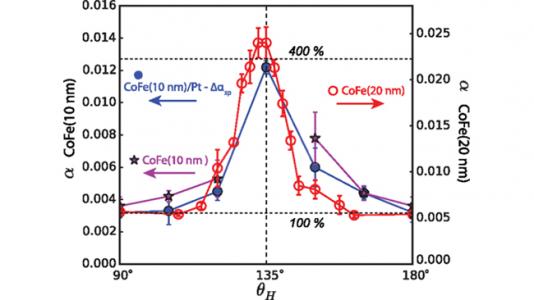
Scientific Achievement
We have discovered a giant anisotropy of Gilbert damping, by 400%, in metallic epitaxial Co50Fe50 thin film devices. This large anisotropy is found to originate from the variation of spin-orbit coupling in the disordered cubic alloy.
Significance and Impact
This discovery and the underlying mechanism open a novel strategy to tune the intrinsic Gilbert damping in metallic ferromagnets, a key parameter that is crucial for applications such as magnetoresistive random-access memories (MRAM) and magnonics.
Research Details
- Up to 400% change of Gilbert damping is obtained in epitaxial Co50Fe50 thin-film devices, measured by both spin-torque and inductive ferromagnetic resonance.
- First-principles calculations point to the variation of spin-orbit coupling in disordered cubic alloy as the origin of the damping anisotropy in Co50Fe50, which is further corroborated by the angular dependence of anisotropic magnetoresistance.
Work was performed in part at Argonne’s Computation facility.
Argonne National Laboratory seeks solutions to pressing national problems in science and technology. The nation’s first national laboratory, Argonne conducts leading-edge basic and applied scientific research in virtually every scientific discipline. Argonne researchers work closely with researchers from hundreds of companies, universities, and federal, state and municipal agencies to help them solve their specific problems, advance America’s scientific leadership and prepare the nation for a better future. With employees from more than 60 nations, Argonne is managed by UChicago Argonne, LLC for the U.S. Department of Energy’s Office of Science.
The U.S. Department of Energy’s Office of Science is the single largest supporter of basic research in the physical sciences in the United States and is working to address some of the most pressing challenges of our time. For more information, visit https://energy.gov/science.